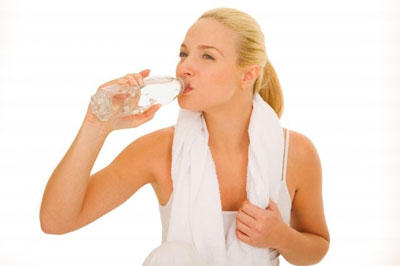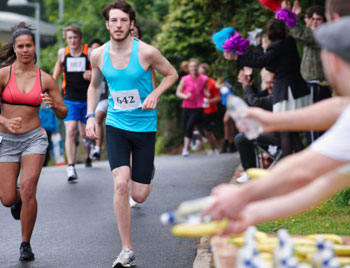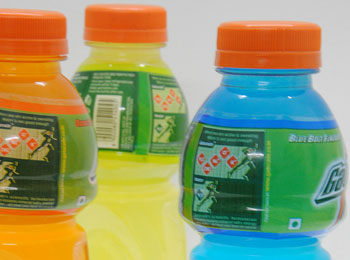-


-

- EXERCISE & HYDRATIONLIFESTYLE ADVISORY
-
Water is an essential nutrient necessary for life. Water makes up to 40-70% of total body mass. Muscle contains 70% of water by weight. The function of water is for transportation of nutrients and waste products, as a solvent for chemical reactions, lubrication for and between cells, sweating and regulation of body temperature and blood circulation and pressure. The maintenance of water balance is essential for health and this balance is regulated by water input (drinking) and water output (perspiration, urine) from the body.
Typical daily intake:- Liquid= 1.2 L
- Food=1.0 L
- Water produced during energy reactions=0.35 L
Water Loss:- Urine= 1-1.5 L
- Skin as insensible perspiration= 0.85 L
- Water vapour in expired air= 0.35 L
- Faeces= 0.10 L
People and athletes perform physical activity throughout a range of environmental conditions such as temperature, humidity, sun, wind exposure. Depending upon the metabolic rate, environmental conditions and clothing worn, exercise can induce significant elevations in body (core and skin) temperatures. To get rid of the excess heat, the body secretes sweat. The evaporation of sweat is the primary mechanism of heat loss during exercise. Sweat is primarily composed of water and electrolytes such as sodium, an excess loss may lead to dehydration and hyponatremia (less sodium). This can affect the athlete’s performance and health.
DEHYDRATION
Dehydration refers to the process of reducing body water either through illness, physical exertion, thermal stress, or water deprivation. Dehydration limits sweating and heat dissipation, causing increased core temperature, reduced exercise tolerance and increased risk for heat-related injury.
Dehydration can lead to:- Muscle fatigue
- Loss of coordination
- Inability to regulate body temperature
- Heat illness (e.g., cramps, heat exhaustion, heat stroke)
- Decreased energy and athletic performance
FLUID REPLACEMENT:
Before Exercise:
According to American College of Sport Medicine, when hydrating prior to exercise the individual should slowly drink beverages (approximately 5–7 ml per kg body weight) at least 4 h before the exercise task. If the individual does not produce urine, or the urine is dark or highly concentrated, the athlete should slowly drink more beverages (for example, another 3–5 ml per kg body weight) about 2 h before the event. By hydrating several hours prior to exercise there is sufficient time for urine output to return towards normal before starting the event. Consuming beverages with sodium (20–50 mEq per liter) and or small amounts of salted snacks or sodium-containing foods at meals will help to stimulate thirst and retain the consumed fluids.During Exercise:
According to American College of Sport Medicine, the goal of drinking during exercise is to prevent excessive dehydration (> 2% BW loss from water deficit) and excessive changes in electrolyte balance to avert compromised exercise performance. The amount and rate of fluid replacement depends upon the individual sweating rate, exercise duration, and opportunities to drink.After Exercise:
The goal is to fully replace any fluid and electrolyte deficit. According to American College of Sport Medicine, consumption of normal meals and beverages will restore hydration. Individuals needing rapid and complete recovery from excessive dehydration can drink approximately 1.5 L of fluid for each kilogram of body weight lost. Consuming beverages and snacks with sodium will help expedite rapid and complete recovery by stimulating thirst and fluid retention.
-
HOW TO CHECK FOR HYDRATION:
According to American College of Sport Medicine, thirst is not a good indicator of hydration and should not be used to monitor hydration status. One way to check hydration status is to weigh before and after exercise. Any weight loss is likely from fluid loss, so drinking enough to replenish these losses will maintain hydration. Over a one percent loss in body weight indicates dehydration and over five percent indicates serious dehydration.
% Body Weight Change:- Well Hydrated -1 to +1%
- Minimal Dehydration -1 to -3%
- Significant Dehydration -3 to -5%
- Serious Dehydration > -5%
Another way to check hydration status is the urine color test. The darker the color, the more dehydrated the athlete is.
Sports drink contain carbohydrates in the form of glucose or glucose polymer and electrolytes such as sodium (Na) and potassium (K) formulated in concentration that is easily absorbed and not irritating to the stomach.
May be appropriate for intense activities with duration of 60 minutes or more (distance running, cycling, sports team practice).
Recommended for activities performed in heat and/or humidity.
-Electrolyte depletion can be an issue for long duration events and water alone may over dilute the electrolytes and cause hyponatremia (less sodium)
PREVENTION OF HYPONATREMIA:
- Refraining from over-hydration by not consuming more than 1000 ml of plain water each hour either before, during or after exercise
- Adding a small quantity of sodium (approx. 25mEq/L) to the ingested fluid
- Also include some glucose in the rehydration drink as it facilitates intestinal water uptake via the glucose – sodium transport mechanism

TIPS
Fluid intake before exercise:- Check your hydration status before exercise because there is a wide variability in fluid needs for each person.
- Drink 16-20 fluid ounces of water or sports beverage at least four hours before exercise.
- Drink 8-12 fluid ounces of water 10-15 minutes before exercise.
Fluid intake during exercise:- Drink 3-8 fluid ounces of water every 15-20 minutes when exercising for less than 60 minutes.
- Drink 3-8 fluid ounces of a sports beverage (5-8 percent carbohydrate with electrolytes) every 15-20 minutes when exercising greater than 60 minutes.
- Do not drink more than one quart/hour during exercise.
Fluid intake after exercise:The goal is to correct your losses within two hours after exercise.- Drink 20-24 fluid ounces of water or sports beverage for every half kg lost.